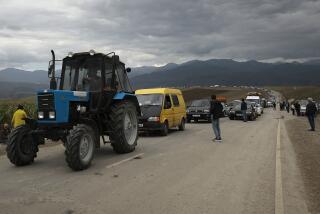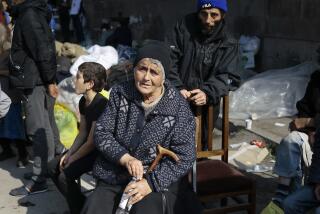Armenia-Azerbaijan War Traps Old Soviet Regiment : Caucasus: The soldiers want no part of the ethnic conflict, and Moscow has finally ordered them out.
- Share via
STEPANAKERT, Azerbaijan — They’re the loneliest guys in what used to be the Soviet army, and now in mortal danger.
During the past weeks, as the artillery shells and rockets exploded around them, and occasionally on their base, the men of the 366th Motorized Rifle Regiment of the 23rd Division, 4th Army have been asking: Does anybody in Moscow remember we’re here, right in the midst of a war?
A blast, shatteringly close, rent the air one recent afternoon as three young officers stood around in the leaky-roofed guardhouse ruing their collective fate. A pimply enlisted man wearing a bulletproof vest arrived on the run.
“Hey, comrade lieutenants!” the private said, and held out his hand to display a jagged hunk of gray metal.
“This fell over in the engineers’ motor pool,” he announced, as the officers examined the shrapnel.
The 366th, bristling with state-of-the-art technology for war, had just come under fire. Its soldiers were heirs of the mighty army that once held Europe, Asia and America in awe. So what action would the regiment take?
“None,” a junior lieutenant from Krasnodar scowled. But why? “Orders.”
Stationed decades ago in this mountain city to stand off the Turkish army, the second-biggest in NATO, the 366th now finds itself the unwilling spectator, potential arbiter and sometime victim of the deadly ethnic feud between Azerbaijanis and Armenians. It is the last remnant of the ex-Soviet military left in Nagorno-Karabakh.
The Azerbaijanis want the Ivans of the 366th to go home, but first to hand over their equipment and munitions, which the Baku government says is nothing more than its rightful share of the Soviet breakup.
Conversely, the Armenians who make up a majority of Nagorno-Karabakh’s population are afraid that if the Azerbaijanis get their hands on the unit’s property, their homeland’s campaign to break away from Azerbaijan will be doomed.
“This is the most powerful regiment of the ex-Soviet army--if not in all the Caucasus, then in Azerbaijan,” said Serge Sarkisyan, a former Communist youth official coiffed like Roy Orbison who now leads the Karabakh Self-Defense Forces headquarter’s staff.
The 366th, the Armenians say, has 1,000 to 1,200 men under arms, plus 12 T-72 main battle tanks, 19 long-range howitzers and numerous armored infantry fighting vehicles with automatic 23-millimeter cannons that can fire 500 rounds a minute.
“We cannot permit Azerbaijan to get their hands on that equipment; it could be decisive,” Sarkisyan said.
On Friday, as their base came under more fire from Azerbaijani artillery, the men of the 366th learned that Moscow had not forgotten them: They received orders to pull out, to prevent their being drawn directly into the fighting.
The order, which also applies to guards on the Armenian-Azerbaijani border, came from Air Marshal Yevgeny I. Shaposhnikov, top military commander of the Commonwealth of Independent States. Commonwealth officials said security will also be tightened at all bases in the Transcaucasus where military equipment is stored.
Meanwhile, news reports said Khojaly, the second-biggest Azerbaijani town in Nagorno-Karabakh, had fallen to Armenian irregulars. The Azerbaijanis claimed that 1,000 of their people were killed and declared three days of mourning.
This was still the Soviet Union until two months ago, but the officers of the 366th speak of their post as if it were a lonely garrison somewhere in Afghanistan.
“Both sides here are crazy,” one said. “We don’t want to help either. We just want out.”
One Siberian-born lieutenant who had served in the Soviet forces deployed in East Germany interjected, “If you ask me where I felt more at home, I can answer in one word: Deutschland.”
The regiment’s walled garrison is a museum of Communist agitprop, with billboards showing a bright red map of the now-defunct Soviet motherland and a resolute Soviet warrior with a jutting chin. The toilets are filthy, the food supply uncertain.
“When we get bread, it’s a joy,” said one officer from Ukraine.
But in this shell-shattered city, to which 20,000 Armenian refugees are said to have flocked from other areas of Azerbaijan, the base seems an Eden. Civilians pleading for drinking water or cigarettes flock to the gate, where a round-faced Kazakh sentinel with a Kalashnikov turns them away.
Not everyone hanging around has friendly intentions. The Armenians have been keeping up a 24-hour vigil outside the 366th’s garrison, ready to bottle up the base’s three entrances with dump trucks and other heavy vehicles to prevent the T-72s and other hardware from being removed.
The interior minister of Azerbaijan, Maj. Gen. T. M. Kerimov, has gone on record as saying, “We know for sure that this regiment incorporates a group of Armenians.” But anyone watching the officers come and go sees mainly the pinkish faces of Russians and other Slavs, and conscripts from all over the former Soviet empire.
A relic of that same defunct empire, the 366th was initially given strict orders to stay out of the struggle raging around it. No one, however, told the men how to defend themselves. One was shot to death outside the gate a few weeks ago by people said by Armenian leaders to be common criminals with guns, not Karabakh nationalists.
It was last Sunday, however, that brought the brunt of this 4-year-old conflict down on the heads of the 366th. On that day, according to authorities here, the Azerbaijanis fired no fewer than 145 rockets into Stepanakert. There were attacks on troops and weapons depots elsewhere in Azerbaijan.
Two volleys loosed by a Grad multiple-rocket launcher slammed into the 366th’s garrison, killing at least one soldier and wounding 15 others. The regiment and the city’s civilian population spent much of the next day clearing the rubble.
Only then did Moscow and the Transcaucasian Military District drop the official policy of non-interference and order the 366th to shoot back if attacked.
More to Read
Sign up for Essential California
The most important California stories and recommendations in your inbox every morning.
You may occasionally receive promotional content from the Los Angeles Times.










